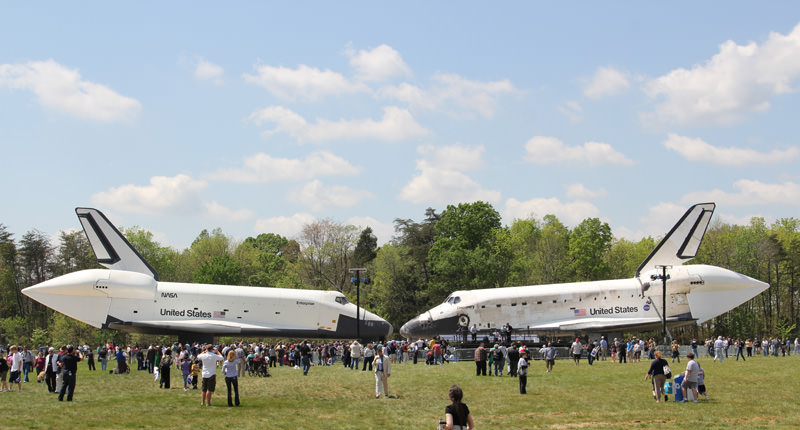[/caption]
Two NASA Space Shuttles – Enterprise and Discovery – sit nose to nose in a historic, once in a lifetime meet up at the Smithsonian’s National Air & Space Museum Annex in Virginia on April 19, 2012 for the official transfer of ownership from NASA to the Smithsonian.
Space Shuttle Discovery was the first orbiter retired from NASA’s fleet of three space flying shuttles. It completed 39 missions, spent 365 days in space, orbited the Earth 5,830 times, and traveled 148,221,675 miles.
Discovery was ferried to the museum on April 17 after arriving atop a 747 Jumbo jet and a series of triumphant fly arounds of the US Capitol region.
Discovery takes the place of Enterprise. NASA says Discovery will commemorate past achievements in space and serve to educate and inspire future generations of explorers at the Smithsonian center.
Discovery is now open for public viewing.
Enterprise is being flown to New York City on April 23.
Photo gallery to follow.


Amazing image. Imagine a family portrait of all 4 (5) orbiters together! Oh wait… I forgot; half of the fleet exploded and killed everyone on board. Whilst a great endeavor, and part the greatest endeavor of all time, exploration of space, let’s not forget that the shuttle program was also a massive failure because of the above little fact.
Space exploration (and related fields like space tourism) will always be a risky business. The tragic accidents of Challenger and Columbia were unfortunate, but they served as important lessons and served to improve the safety of future missions. The protocols put in place after each incident ensured the lives lost were not in vain, and instead served to enhance the safety of future missions.
NASA, its astronauts, other countries’ space authorities, and private space companies are all aware of the risks of space travel. The only truly failed experiment is the one never attempted.
It certainly wasn’t a technical failure, though perhaps one of design (in hindsight). The program failure I allude to was logistical I suppose–the fools in management that caused Challenger to fail, for instance.
So the entire program can be marked as a failure because several people died? I guess we can mark the automobile, sailboat, steam locomotive, diesel train, airplane, and (as far as I can tell) every other form of human transport a failure as well.
The Shuttle was never supposed to explore space, it was supposed to be a reliable way to get materials to the ISS so that unprecedented 0-G research could be done. It did that.
Then by your account, all those ships that sunk ~600 years ago meant a “massive failure” for those explorers foolish enough to leave the dry ground of Europe.
Interesting and odd perspective!
No I originally said “also” meaning that it can be interpreted as such; it’s also a massive success in various ways. And just of that program, not space endeavor in general as you suggest. As for european explorers, that whole era was a failure for the native population and culture they destroyed without justification (and then became ultra selective about who’s allowed to “immigrate”, incidentally–standard idiotic human behaviour I guess). Anyway it all depends on perspective, is all…
Always with the negative waves, Moriarty!
Nope just skeptical. I’m a #1 supporter of space activity but that doesn’t mean all ideas are good. Ones that are poorly designed and exectued, get underfunded, then blow up, shouldn’t be blidnly endorsed–otherwise nothing much will end up getting done…oh wait, that’s what’s happened since Appollo 😉
What’s up with the ass-cones? Looks terribly wrong 🙁
They’re mounted on there to reduce drag for when it’s on top of the 747 in transport.
WTF? The Enterprise has it’s shields down!
Ready to go! Your shuttle has been prepared for you according to Enterprise Rent-A-Shuttle standards. We have taken the time to clean and inspect this vehicle, which includes: cleaning interior, checking fluids and tyres, washing exterior. 🙂